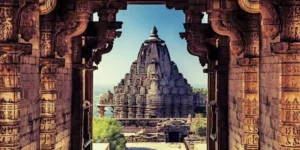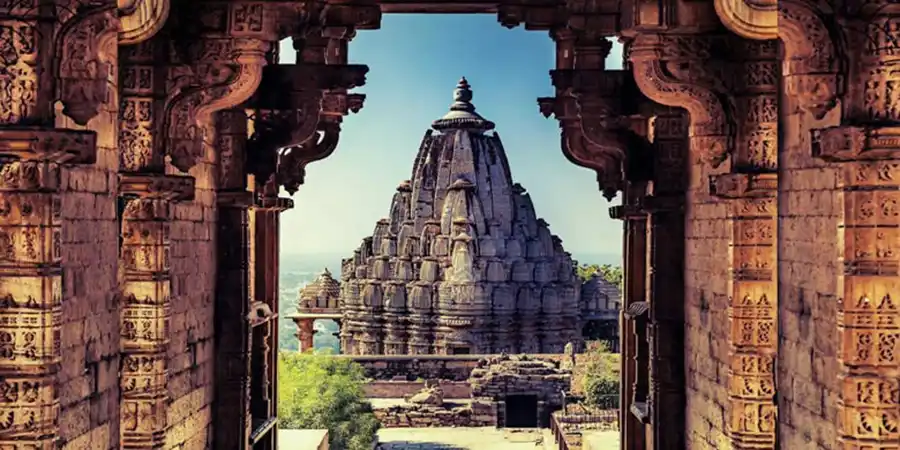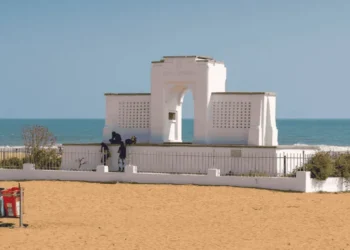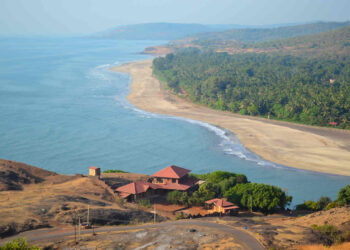Rajasthan, the land of kings, pulses with spiritual devotion and cultural heritage. Its temples, carved from ancient stone or gleaming with modern marble, carry tales of faith, art, and history. From desert shrines to hilltop sanctuaries, each holds a unique spirit. This blog explores 21 distinct temples in Rajasthan, sharing their past, design, rituals, and special traits, offering a window into the state’s sacred heart.
- Brahma Temple, Pushkar
Near Pushkar Lake, this rare 14th-century temple is dedicated to Lord Brahma, the creator of the universe. Its marble spire, painted red, rises over a 4-foot four-faced Brahma idol. Legend says Brahma performed a sacred fire ritual here, blessing the lake. During Kartika Poornima, devotees dip in the waters, seeking divine wisdom.
- Karni Mata Temple, Deshnoke
In Deshnoke, 30 km from Bikaner, this 20th-century temple reveres Karni Mata, a Durga incarnation. Known as the “Rat Temple,” it shelters 25,000 black rats, called kabbas, fed milk as holy beings. Maharaja Ganga Singh’s silver doors, etched with gods, is art in itself. Pilgrims pray here for safe journeys.
- Eklingji Temple, Udaipur
In Kailashpuri, 22 km from Udaipur, this 8th-century Shiva temple boasts a 50-foot stone tower. Its four-faced black marble Eklingji idol, carved in 734 AD, draws Mewar royals. Rebuilt after invasions, it hosts Shravan fairs where devotees offer bilva leaves, believing Shiva grants strength.
- Birla Mandir, Jaipur
On Moti Dungari Hill, this 1988 temple, built by the Birla family, worships Lord Vishnu and Goddess Lakshmi. Its three marble domes symbolize India’s faiths. Walls bear Geeta verses and names of sages like Zoroaster. Diwali brings lantern festivals, lighting the temple’s gardens.
- Salasar Balaji Temple, Churu
In Salasar, this 1754 temple honors Lord Hanuman with a 5-foot idol, said to have emerged from a farmer’s field. Devotees tie coconuts during Chaitra fairs, praying for courage. The stone shrine’s simplicity reflects Hanuman’s devotion, drawing thousands to its vibrant rituals.
- Ranakpur Jain Temple, Pali
Built in the 15th century under Rana Kumbha, this Jain temple venerates Lord Adinath. Spanning 48,000 square feet, it has 80 domes and 1444 marble pillars, each uniquely carved. A 108-headed serpent relief guards the hall. Jains offer rice in silent prayers.
- Mehandipur Balaji Temple, Karauli
In Dausa, this 18th-century Hanuman temple is known for exorcism rituals. Its stone sanctum holds a sindoor-smeared idol. Devotees chant mantras on Tuesdays, seeking freedom from spirits. Ancient pillars bear warrior carvings, tying the temple to Rajput battles.
- Dilwara Jain Temples, Mount Abu
Built between the 11th and 13th centuries by Vimal Shah, these temples honor Jain Tirthankaras like Adinath. Their marble carvings, with lotus and dancer motifs, rival fine lace. The Vimal Vasahi’s floral ceiling amazes visitors. Jains anoint idols with sandalwood paste.
- Ambika Mata Temple, Jagat
In Jagat village, 50 km from Udaipur, this 961 AD temple worships Goddess Ambika, a Durga form. Its pentagonal stone structure has Khajuraho-style carvings of dancers. Navratri brings women’s sword dances, honoring Ambika’s power, preserved by Rajasthan’s Archaeology Department.
- Galtaji Temple, Jaipur
Nestled in the Aravalli Hills, 10 km from Jaipur, this 18th-century complex honors Shiva, Hanuman, and the Sun God. Seven holy springs feed ritual baths. Called the “Monkey Temple” for its 2000 monkeys, it hosts kite-flying during Makar Sankranti, filling the sky with color.
- Tanot Mata Temple, Jaisalmer
Near the Indo-Pak border, 18 km from Longewala, this 8th-century temple worships Goddess Tanot. It survived 1971 war bombings, with unexploded shells kept in a museum. Run by the BSF, it has a victory pillar for soldiers. Devotees offer brass bells for safety.
- Rani Sati Temple, Jhunjhunu
This 17th-century temple honors Rani Sati’s bravery with a trident, not an idol. Its 10-acre marble courtyard, Rajasthan’s largest, hosts Bhado Amavasya fairs with folk plays about Rani’s sacrifice. Women tie threads, praying for family protection.
- Govind Dev Ji Temple, Jaipur
Within Jaipur’s City Palace, this 18th-century temple venerates Lord Krishna. Maharaja Sawai Jai Singh brought its 3-foot idol from Vrindavan, carved by Krishna’s kin. Janmashtami’s swing ceremony features Marwari bhajans, with the idol draped in silk.
- Parshuram Mahadev Temple, Pali
This cave temple, 3995 feet above sea level, honors Lord Shiva. Reached by 500 stairs, it has nine ever-full water kunds and a rock-carved Ganesha. August fairs see Bhil tribal dances celebrating Parshuram’s axe, a symbol of divine justice.
- Kiradu Temples, Barmer
In Barmer, 35 km away, these 11th-century temples boast Solanki-style architecture. The Someshvara Temple, for Shiva, has erotic carvings, dubbed “Khajuraho of Rajasthan.” A curse legend claims the town was abandoned. Stone slabs narrate royal conquests.
- Sai Dham Temple, Kishangarh
Built in 1996, this temple honors Shirdi Sai Baba with a 5.5-foot white marble idol. Thursdays feature sandalwood havans. A free medical camp, run by a Mumbai trust, serves 5000 patients yearly. Devotees drape chaddars over Baba’s samadhi.
- Jagdish Temple, Udaipur
Built in 1651 by Maharana Jagat Singh, this Indo-Aryan temple worships Lord Vishnu. Its 79-foot spire has elephant carvings. A brass Garuda statue guards the 3-foot idol. Evening aartis include flute music, evoking Krishna’s divine charm.
- Ramdevra Temple, Pokhran
In Pokhran, 12 km away, this 19th-century temple marks saint Baba Ramdevji’s resting place. A sandstone horse statue honors his travels. Pilgrims offer jaggery during Bhado fairs for safe journeys. Folk paintings on the walls depict his miracles.
- Achal Nath Temple, Jodhpur
Built in 1531 by Queen Nanak Devi, this Shiva temple in Jodhpur has a simple black linga. Its Shivratri fair draws Rathore clans, honoring ancestors. A nearby stepwell supplies ritual water. Devotees pour milk during Shravan for blessings.
- Kodamdesar Temple, Bikaner
Founded in the 15th century by Rao Bikaji, 24 km from Bikaner, this temple honors Bhairon Ji. Its golden domes, built by merchants, shine in the desert. Navratri camel races celebrate Bhairon’s speed. Red threads are tied for protection.
- Meera Temple, Chittorgarh
In Chittorgarh Fort, this 15th-century temple, built under Rana Kumbha, celebrates Meera Bai’s devotion to Krishna. Its 3-foot Krishna idol, adorned with peacock feathers, inspires bhajans. Meera’s handwritten poems, kept in the fort museum, draw poets and devotees.
Conclusion
Rajasthan’s 21 temples, from ancient ruins to royal shrines, form a sacred mosaic. Each, with its own history, design, and rituals, pulses with devotion. For pilgrims and travelers, these sites offer  a profound journey into Rajasthan’s spiritual soul.
a profound journey into Rajasthan’s spiritual soul.











